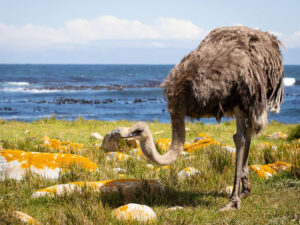The Ecotourism Dilemma

By Sean Beckett, Program Director
In a time of global biodiversity collapse fueled by climate change, how does a nature center justify global ecotourism? Is this sort of travel a net harm to the planet?
If carbon footprint were the only consideration, then yes. Climate change is a clear and present danger to all the world. To help address our impact, beginning in 2025, all of our Adventures Afar trips will be carbon neutral via carbon offsets. See the bottom of this post for more.
But at the scale of individual species and habitats, our focus on personal carbon footprints and climate change obscures the related-but-even-more-acute threats of biodiversity loss from fragmentation, deforestation, invasive species, poaching…you know the list. Ecosystems strain under a precipitously warming climate, but extinction comes quickest at the blade of a bulldozer.
The development of thoughtful ecotourism has often staved off such destruction. The encroachment of slashand-burn agriculture in the Panama highlands stalls when tropical birdwatchers inject ecotourism dollars into local economies. Elephant poaching in South Africa’s Kruger National Park disappeared for decades as safari tourism transformed gateway communities. Wolves thrive in Montana in part because wolf watching generates four times the income of elk hunting in some regions. Of course, there are myriad counter-examples where extractive ecotourism sows inequity or harms the very animals it aims to highlight, so each traveler has a responsibility to carefully choose businesses that operate conscientiously.
Likewise, each traveler has a responsibility to ensure that their reasons for travel are worth the journey’s impact. With intention, these experiences are deeply and permanently transformative. As the countless tears wiped from our spotting scopes attest, watching a wild wolf is not like seeing one on TV. Spiritual fulfillment is found among the sacred creatures that symbolize one’s love of nature. And for some travelers, the experience may kindle a hobby into a fire of environmental advocacy for species that may not exist in a generation.
We do our best at NBNC to navigate the pros and cons of every trip, and offer only those that we feel will benefit the environment. Part of that calculus honors each participant’s
justifications for going. The sublime exists in Vermont’s woods, and deserves to be treasured. But awe and wonder come in different flavors in the rainforests and savannas.
Sitting by the wood stove, I recall that the amount of carbon in a cord of firewood is about the same as a seat on a flight to and from the Arctic Circle. Once there, would the polar bear say to me “how dare you?” Surely the last thing it needs is another two thousand pounds of carbon melting the arctic. Or might it say “thank you?” Of all the world’s billions of people, here is one who came to pay his respects, to learn, and to bear witness to the planet’s greatest and most tenuous treasures.
We invite you to join us in learning how we can better ask and answer these sorts of questions. It is a privilege for NBNC to connect people with nature across the world, and to work together with our travelers to do so in a way that protects the biodiversity to which we are all accountable.

More About Carbon Neutral Travel with NBNC
NBNC is proud to announce that all of our trips from 2025 onward are 100% carbon-neutral. This includes each traveler’s flights to and from this destination, as well as carbon emitted during the trip.
How it Works: The voluntary carbon market has come under intense scrutiny in recent years as the legitimacy and effectiveness of many carbon offsetting projects have been called into question. That’s why we’re proud to be working directly with the Northeast Wilderness Trust’s Wild Carbon program. The carbon credits we purchase to offset our carbon emissions are used to permanently conserve forestland as wilderness. Why wilderness offsets?
- It’s Permanent: Unlike most contracts in the voluntary carbon market that have a lifespan of just 10-20 years, wilderness conservation is forever.
- It’s Additive: Acreage purchased and conserved through wild carbon offsets would not be protected anyway through another mechanism later.
- It’s “Leakproof:” Forest protection often just shifts and concentrates timber harvest elsewhere. But wilderness conservation is different–wilderness protection here doesn’t just move carbon emission over there. That’s because old forests function very differently than young ones. Big trees and old soils capture and store vastly more carbon than a young forest of the same acreage. Growing an old forest is like building a natural carbon sequestration factory!
- It’s More than Carbon: With wilderness protection comes additional co-benefits like biodiversity conservation, flood resilience, and habitat connectivity. This way, going carbon-neutral isn’t just negating our carbon footprint, it’s also actively helping conservation in other ways.
Want to learn more?:
- Check out this FAQ for NBNC travelers about Northeast Wilderness Trust’s Wild Carbon Program.
- To learn more about forest carbon storage, please watch Understanding Forest Carbon by climate forester Dr. Ali Kosiba.

